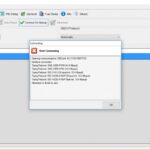Connecting a car diagnostic scanner, often a Bluetooth OBDII scanner, is a straightforward process that can unlock a wealth of information about your vehicle’s health and performance. This guide will walk you through the simple steps of installing and using one.
Locating the OBDII Port
Most vehicles manufactured after 1996 have an OBDII port, typically located under the dashboard on the driver’s side. It’s a standardized 16-pin connector, often within reach of the steering wheel. Sometimes, it might be hidden behind a panel or near the center console. If you’re having trouble finding it, your vehicle’s owner’s manual should provide its exact location.
Connecting the OBDII Scanner
Once you’ve located the OBDII port, simply plug the scanner in. Ensure it’s firmly connected. The scanner’s power LED should illuminate, indicating a successful connection to the vehicle’s computer system. Different scanners might have varying LED indicators, so refer to your scanner’s manual for specifics.
Pairing with a Diagnostic App
Most OBDII scanners communicate wirelessly via Bluetooth. You’ll need a compatible diagnostic app on your smartphone or tablet. Popular options include Torque Pro, OBD Fusion, and Car Scanner ELM OBD2. Download and install your chosen app from the app store.
Open the app and initiate the Bluetooth pairing process. It will search for available devices. Select your OBDII scanner from the list of discovered devices. You may need to enter a PIN code, often “0000” or “1234,” but consult your scanner’s documentation for the correct code.
Reading Diagnostic Trouble Codes (DTCs)
Once paired, the app can communicate with your vehicle’s computer. The most common function is reading Diagnostic Trouble Codes (DTCs), which are error codes stored when the vehicle detects a problem. In the app, navigate to the “Read Codes” or similar option to initiate a scan. The app will display any stored DTCs along with their descriptions.
Accessing Live Data
Beyond reading codes, many apps display live data from various sensors in your engine and transmission. This real-time information can help you monitor engine performance, fuel economy, and other crucial parameters. Explore your chosen app’s features to understand the full range of data available. For instance, you might be able to monitor coolant temperature, engine RPM, and speed.
Utilizing Advanced Features
Some apps offer advanced features such as data logging, performance tests, and even customizability for experienced users. Depending on the app and scanner combination, you might have access to emissions data, ABS information, and other specific vehicle systems.
By following these simple steps, you can easily install and utilize a car diagnostic scanner to gain valuable insights into your vehicle’s operation and identify potential issues.

